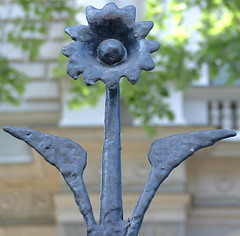At barcampSeattle, Bryan, Dylan, Matt, I, and several others started a dialog about helping people adopt accessible design practices. The summary of our discussion was, "make it cheap and easy." Last week, inspired by a comment from tantek, the dialog continued on twitter. We compared accessible design to green/environmentally-friendly design....and doughnuts. :)
I've been working on a mental stew with the following ingredients:
- "Animal, Vegetable, Miracle" about one family's year-long localvore experiement - eating foods raised by themselves or neighbors and minimizing the cost of fuel used to produce and consume the foods they eat.
- "Vegetable Gardening West of the Cascades" about the benefits of gardening in the Seattle area and how we could eat fresh veggies from our gardens year-round...assuming climate change doesn't shift our winter temperatures too many degrees.
- We're preparing to paint the outside of our house and I've been researching the greenest option - paint or stain. Which lasts longer? What are the effects on the environment? Where are the materials produced and how much fuel will it take to ship to our painter? The costs and products are not quite there yet, which is frustrating for me as a consumer.
- My son is toilet training which means many more flushes of our toilets. We received the water bill yesterday and are consuming noticebly more gallons of water *per day.* What if we only had so much water in a cistern or a well and couldn't just pull more from the city? When will I be able to view our water supply like I do our bank account? When we overdraw, it has to come from somewhere.
- I'm co-writing a book on Universal Design of web applications and I've been tearing apart, challenging, and reconstructing my knowledge about accessibility, disability studies, culture, and web technologies.
<stream-of-consciousness>
As a consumer, I *want* to do the green thing. I want to buy efficient toilets and use the least toxic paint. I am driven by making the world a better place, not only for myself, but for my son. What holds me back are costs and fears. The fears are: How long will the water-based paints last? Will they protect my house as well as paints with pest/herbicides? In Seattle, where there is so much water on wood, this is a big question. The costs are: Water-based paints costs almost twice per gallon than latex paints. Stains need to be reapplied more often. Then, there's what I prefer. I like the way paint looks.
I am trying to understand the point of view of designers and developers who have not whole-heartedly adopted web standards and accessibility. I think they have similar struggles with fears and costs. I believe that most people want to do the right thing but they aren't sure they know how, don't have the time to find out, and fear the costs.
If I were to put in more efficient toilets, the city of Seattle would give me a rebate. I assume the reasoning by The City of Seattle goes something like: We're all in this together, so if more people save water there will be more water for all of us. I guess I get my own tax dollars back when I contribute to the greater good.
While I think there are plenty of reasons to make your sites accessible, perhaps monetary incentives would help. I don't know where we'd get the funding, but imagine if you added appropriate alt-text to all of the images on your site, you could get a rebate. What do you think? Would it work? If we could raise the money, is there a better way to spend it (like buying technology for people with disabilities)? do you have other ideas to make accessible design "cheap and easy?" Is that the right target? Other thoughts?
</stream-of-consciousness>

2 comments:
I can't believe that you haven't carefully read
http://en.wikipedia.org/wiki/Composting_toilet
Love.
Is there any way that people who do have accessible websites can "donate" their format/coding to others who want an acceessible site - or to designers -with the stipulation that they not copy design/text but only the invisisble bits relevant to making someone else's site accessible as well? (I'm getting an accessible site built, I am not a developer and am highly ignorant of the whole subject so please gleen the spirit and not the technical accuracy of this post)
Post a Comment